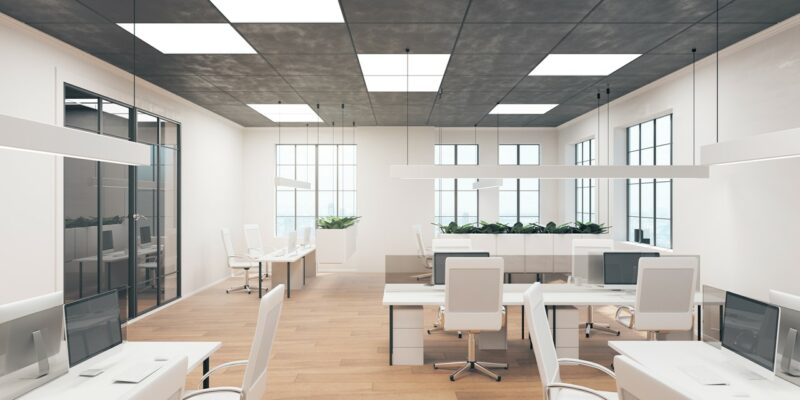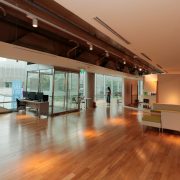Creating a commercial lighting design involves many considerations aside from light and color selection. The lighting solution that you choose can generally affect the overall ambiance in the office, including the cognitive well-being and enthusiasm of the employees towards their work.
Many people have a one-sided opinion about lighting and that its only purpose is to illuminate spaces. However, modern designs perfectly balance functionality and aesthetics regarding office lights since it is the most creative and easiest way to enhance the work environment.
There are also energy codes to follow, concerns about energy costs and efficiency, and the need to integrate flexibility for easy adjustments as the business grows and lighting changes. Ultimately, the primary goal of proper lighting in the office is to encourage productivity by improving the employees’ well-being.
Factors Affecting Office Lighting Design
With so many lights and fixtures, choosing what type of lighting is the most suitable for your office can be pretty challenging. To help streamline the selection process, here are the essential factors that you need to consider:
1. Office Lighting Standards
The governing institution that sets the minimum required office lighting for all commercial spaces in the United States is the U.S. General Services Administration (GSA). According to their standard policy for interior lighting consideration, a typical workstation on open or closed offices requires a nominal illumination level of 500 lumens per square meter.
The association also mandates other office lighting standards, such as:
- There must be a combination of fluorescent and dimmable incandescent lights in conference and training areas.
- The lighting design must evenly illuminate the office space.
- Lighting fixtures must be installed at all entrance and exit points
- Task lighting must fill the lighting gaps
- Exit signs must have LED lighting with an EnergyStar rating and meet the requirements of NFPA 101.
Overall, the GSA lighting standards aim to enhance the architecture and the individual spaces within the building using effective lighting strategies.
2. Color and Contrast
It is crucial to incorporate the right color temperature and color rendering index (CRI) into your commercial lighting because the lights you choose for your space can help project the image and brand of your business. Warm shades such as orange and yellow are ideal for relaxing areas since they can make the room smaller and more comfortable. Lighter shades such as cool blue or white lights make a room more spacious and are better for work and concentration.
The color and temperature of the lights should vary based on the function of the space. Designers consider the amount and intensity of light and the connection of the different spectrums to our health and mood.
3. Brightness Intensity
When creating an office lighting plan, it’s essential to keep the brightness and light intensity in mind. The lights must be bright enough to illuminate the space effectively but not overwhelming in the workstation area. Underlit areas can cause eye strain and tired vision, while overlit spaces may lead to visual discomfort and glare.
Unbalanced light fixtures lead to poor performance since your employees have migraines or are generally uncomfortable. Their productivity decreases and may even cause some efficient employees to quit due to recurring headaches and eye strain.
4. Natural Light
According to a clinical study held by the Department of Design and Environmental Analysis at Cornell University, the majority of the employees exposed to natural light at work reported an 84% drop in eye strain, migraines, and blurred vision. In addition, natural light exposure also helps boost morale, regulate hormones, and improve sleep which is necessary to improve work productivity.
Aside from employee benefits, several illuminating spaces in your office using natural light can significantly reduce energy consumption leading to low energy costs. If there is no opportunity to install larger windows, you may install skylights instead.
5. Light Placement
When selecting a new office lighting fixture, think about where it needs to be placed to encourage productivity and reduce possible eye strains. Consider the general tasks in your office; if your employees are in front of the computer all day, choose a gentle office lighting solution that won’t compete with the light emitted from the computer monitors.
In addition, it would be best to follow the manufacturer’s spacing guidelines. Align the lights along with the shapes of the desks and consider a single fixture or recessed lights for small square tables. The primary objective is to distribute the light in your office evenly.
Layers of Commercial Lighting
Blending and balancing these lighting variations delivers visual allure to the space and produces a more engaging, stimulating, and inviting environment.
1. GENERAL LIGHTING
General or ambient lighting is commonly the primary source of illumination in an office space and can quickly become the main focus for energy efficiency. The recommended light level for general lighting is 30 – 50 foot candles to provide the whole area with proper lighting effectively.
The right level of ambient lighting can affect the employees’ concentration and productivity as diffused lights ensure a sense of well-being and comfort. The most suitable method to accomplish this is by arranging and overlapping recessed fixtures using reflectors and lensed trims.
Vertical surfaces must be adequately illuminated for visual comfort, spaciousness, and visual and directional cues. Sheer brightness makes orientation easier, helps define spaces, and aids in making the space’s appearance larger, open, and more welcoming.
2. TASK LIGHTING
Task lighting is applied to brighten a space for a specific task, providing a focused, localized, and higher illumination level. Necessary to space functioning, it is essential to use energy-efficient sources to reduce operating costs. Task lighting is most effective when supplementing general lighting in workspaces, conference areas, and countertops.
Adequate task lighting should eliminate shadows on the specific illuminated area while preventing glare from the lamp or off surfaces. Glare impedes office work and is accessible to control by increasing the brightness of surrounding areas, decreasing the brightness of the glare source, or both.
Suggested light levels for task areas are 50 – 200 footcandles. When illuminating a work area, consider the distinction in brightness, or contrast, between the task area and the surrounding space.
The quantity of light required on the task is usually the most adjustable variable of task lighting that can be improved to compensate for low contrast levels. For office spaces, utilize a generally low ambient light level with the strategically placed task luminaires.
With this combination, the optimal seeing conditions in the work environment are met, and energy is conserved since the high-level illumination is provided only where it is needed. Task lighting lowers the dependence on overhead lighting and provides a more suitable quality of light for specific tasks.
3. ACCENT LIGHTING
Most commercial businesses value the overall aesthetics of their office spaces since it promotes their brand and somewhat gives visitors and potential clients an idea of the company. Accent lighting helps achieve this goal by supporting the interior design by defining shapes, textures, and finishes using a focused light source.
The key is to enhance the precision and intensity of the light source rather than the surrounding general light. Track fixtures and recessed lights with concealed adjustable illumination points can provide more control and direction since it would be easier to aim at the highlighted object’s best features.
4. DECORATIVE LIGHTING
A decorative lighting scheme can simultaneously contribute to the existing lighting layers in your office and enhance the look and appeal of the space as an additional design element. Some examples of decorative lighting include pendants, sconces, chandeliers, tables, floor lamps, and cylinders.
Adding décor, beauty, and style using decorative lighting is also a significant reflection of a company’s image and reinforces their brand and style of the space. Decorative lighting can also contribute to a sense of hospitality and convenience. In addition to decorative lighting, you can also install plastic ceiling access panels to support the theme in the office and gain better access to wirings and fixtures.
Use Office Lighting to Improve the Workplace
Suppose you’re in charge of making recommendations and deciding the lighting theme in your office. In that case, you have a great opportunity to effectively reduce energy costs by choosing LED lighting and improving work productivity by proper light placement and intensity consideration.
Creating a happy and productive workplace through human-centric lighting solutions shows your employees that you value their well-being. Happy employees eventually lead to higher work quality and output; thus, enabling your business or establishment to thrive in a long time.













[…] satisfaction and customer experience. The ongoing task of regular cleaning, updating furnishings, enhancing lighting, and addressing wear and tear is pivotal for maintaining an atmosphere that is both welcoming and […]